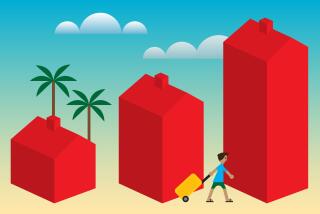Executive Travel : If You Travel in ‘96, You’ll Pay More : Corporate: Changes in the hotel, airline and rental car businesses spell higher rates and less choice next year.
- Share via
With the hotel industry headed for a year of record occupancy rates in 1996, business travelers are going to find it more difficult to find rooms at the last minute, according to industry surveys and travel executives.
Hotel rates will increase, along with air fares and car rental rates, all of which will make planning and cost control even more crucial for business travelers in 1996.
Indeed, hotel occupancy rates, which have been steadily climbing in the 1990s are now approaching levels not seen since the 1970s, said Victoria Linssen, senior manager of American Express’ Consulting Services Group.
Overall, hotel occupancy hit 66.4% in 1995 and is expected to exceed 67% next year, driven by increases in demand, she said. At the same time, the average daily corporate rate is expected to increase 5% to 6% in 1996.
The hotel industry is relishing its hard-won profitability, said Ken Hine, chief executive officer of the American Hotel & Motel Assn. in Washington, D.C. “The latter part of the 1980s was very difficult for the industry,” he said. “It’s the period when we paid for our sins--the easy money, indiscriminate development, and too little attention to market conditions.”
Since then, however, the industry has turned around. “We’ve seen a period of rather remarkable absorption,” Hine said. “It’s given us a wonderful ‘94, an even better ‘95, and we have every reason to believe the same sort of ’96. If things continue this way, we may have one of the longest and most protracted periods of strong occupancies in history.”
The increases have already begun to affect the business travel industry.
“The law of supply and demand will affect the meeting industry bookings as well as the individual traveler,” said Edwin L. Griffin, Jr., chief executive of Meeting Professionals International in Dallas. “Meeting planners are finding less flexibility with dates, rates and other previously negotiable areas.”
In fact, American Express is forecasting a 10% increase in corporate group travel expenditures, including conventions, expositions and meetings for 1996.
And the hotel room crunch doesn’t affect just large groups. Some travelers are finding themselves locked out of some cities during some periods.
“Trying to get a hotel room midweek in New York, Chicago, or Atlanta in the last few weeks has been virtually impossible,” said Ed Gilligan, executive vice president of Travel Management Services.
That’s making matters more difficult for travel managers. “It’s hard to get a reservation, and when you do get a reservation, you’re not getting as good a discount,” said Thomas Nulty, president of Associated Travel Management, a Santa Ana-based travel agency with 200 locations with 85% of its business in corporate accounts. “There is considerably more demand than there appears to be supply, causing prices to go up and causing great stress on travelers’ budgets.”
That is also forcing companies that do manage to negotiate hotel discounts to follow through on their promises to bring more business to those hotels, said other travel managers.
If you make a commitment, you have to keep it, said Dorothy Froix, travel manager for Sundstrand Service Corp. in Los Angeles. “You can’t go from hotel to hotel.” Companies that produce the incremental business they promise in order to get better rates will still find deals, she said. “If you’re a good customer, they’re going to treat you like a good customer.”
But hotel rates aren’t the only prices going up for business travelers.
“Corporate America will spend $5 [billion] to $6 billion more for travel and entertainment next year unless companies take a hard look at their travel management programs,” Gilligan said. “Travel and entertainment spending is the third-largest controllable expense at most companies, and with prices rising, companies should fine tune their travel policies to encourage employees to book earlier and use negotiated corporate rates.”
The average business air fare, for example, is expected to increase another 3% to 4% in 1996, following a 3% increase in 1995, he said.
Rising labor costs, delays in aircraft delivery, and the elimination of less profitable routes have contributed to rising fares, Linssen said. In addition, planes are flying with more seats filled, making it more difficult for companies to obtain corporate discounts, she said.
Higher air fares will cause some companies to reconsider how many people to send on trips. “Where they used to send two to three people, now they’re seeing if they can get away with sending one,” he said. More clients are also considering alternative ways to get to where they’re going, such as using flights with stopovers instead of nonstops, he said.
Car rental prices are also on the upswing, with a projected increase of 4% to 5% for 1996, Linssen said. Rising fleet costs are driving the increase in prices, she said. “Fleet costs have nearly doubled since the early 1990s.” At the same time, however, the supply of rental cars is expected to be tighter in 1996.
The only break corporate travelers can look forward to in 1996 is in meal prices, she said. Competition will keep price increases between 2% and 3%.
(BEGIN TEXT OF INFOBOX / INFOGRAPHIC)
Filling the rooms
Struggling after a binge of hotel building, occupancy rates for U.S. hotels are finally returning to levels not seen for more than a decade.
1995: 66.4%
Source: Smith Travel Research, Laventhol and Horwatch
More to Read
Sign up for The Wild
We’ll help you find the best places to hike, bike and run, as well as the perfect silent spots for meditation and yoga.
You may occasionally receive promotional content from the Los Angeles Times.






